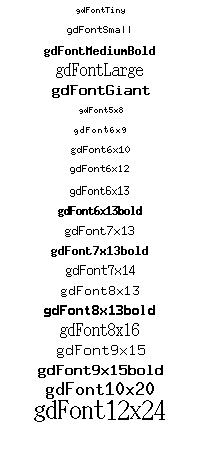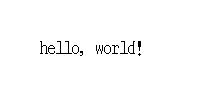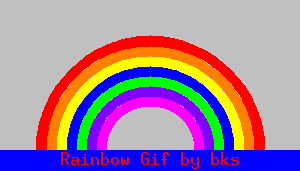
tgd
A text based tool for creating and manipulating GIF images
Provides shell level access to the
gd 1.2
graphics library
Author: Bradley K. Sherman
The latest release of tgd is version 1.2c (7 Oct 1996).
The latest version of the documentation should be available at
http://www.ironic.com/tgd/index.html
.
RCS:$Id: index.html,v 1.2 2002/06/15 17:08:33 bks Exp $
Preface
tgd
reads text files and writes GIF files.
Typically, in a Unix environment, it would be at
the end of a pipe: my_program | tgd.
It can also be invoked on a file: tgd my_text_file.
By using the special file handle stdout, it can
be used in WWW applications to push images to a browser.
It was born out of a desire to learn the
gd graphics library and
Perl
simultaneously (but it can be used with any scripting
language).
I hope that it will allow me to make new tools available
on the World-Wide Web to help molecular biologists cope
with ever increasing quantities of data.
.
Credits & Rights
This program would not exist if Doug Bigwood
had not shown
Thomas Boutell's
gd 1.1.1
graphics library
to me.
To appreciate
tgd
you must read
Boutell's documentation
.
You can find the Credits and License terms of
the gd 1.2 library at
gd.html#notice
or in the
tgd
distribution.
We place no further restrictions on distribution of the source
code other than those attached to the software from which
it is derived except to request that novel software derived from
tgd
include credit to the Dendrome project, Institute of Forest
Genetics, USDA Forest Service.
The Dendrome project is funded by the
USDA ARS Plant Genome Research Program
and by the
USDA Forest Service
.
tgd was written by
Bradley K. Sherman
.
Please send bug reports and comments to
bks@ironic.com
Table of Contents
Change in version 1.2
Font names are now case insensitive.
There are three new fonts: gdFontTiny, gdFontMediumBold and gdFontGiant.
There is a
complete list of fonts
below.
Changes in version1.2b
Font source files are broken up into separate file
to allow compilation on machine where object modules
must be kept smaller. Commands gif and gd will now
accept special filename stdout to mean
write the image files to the standard output
rather than to a disk file.
Changes in version1.2c
Fixed polygon and filledpolygon bugs reported
and diagnosed by Ronan Waide (waider@cork.cig.mot.com).
Where do I get tgd
Compressed with compress (tgd1.2c.tar.Z)
Gzipped with gzip (tgd1.2c.tar.gz)
For VMS users try
Phil Ottewell's port at
http://www.pottsoft.com/home/pds/pds.html
How do I build tgd?
tgd is written in K&R style C. But it
builds with gcc.
It should be possible under *ix to:
% uncompress tgd1.2c.tar.Z
% tar xvf tgd1.2c.tar
% cd tgd1.2c
% make
But this is tested only on a Sun running SunOS 4.1.x. You may need to
fiddle with the Makefiles either in tgd1.2c, or in
tgd1.2c/gd1.2
tgd basics
The general idea is that
tgd
consumes files consisting of lines.
Each non-blank non-comment line
begins with a
tgd
command.
tgd
can be invoked with a list of files as argumemts
% tgd file_a file_b file_c ...
or it can be used as the tail end of a pipe
% perl -e myPerlscript | tgd
Limits on the
tgd
input file
- Characters are ASCII.
- Blanklines are ignored.
- Lines beginning with '#' are ignored.
- Input lines may be no more than 5000 characters.
- no more than 64 simultaneous images
- image handles no more 100 characters
- colornames no more than 100 characters
Color Note:
When an image file is read from disk colornames are
assigned to each color in the file. The names are
are made from a template "#XXXXXX", so tgd
assigns #000000 to a color with r,g,b values 0,0,0
and #FF00FF to a color with r,g,b values 255,0,255.
tgd Commands
The comands:
checksyntax,
debug,
stringcenter,
and stockimage
are unique to
tgd
.
All other commands are analogues of similar
functions in the gd 1.2 library.
The arguments to a tgd command are in the same
order and of the same number as the arguments
to the underlying
gd 1.2 function
.
Thus, for example, the documentation for
gd 1.2 function
gdImageFillToBorder
applies to
tgd
command
filltoborder
.
Commands are case-insensitive.
- arc -- arc handle x y width height start_degree end_degree color
 stockimage im 2
arc im 17 12 20 20 0 270 red
gif im im.gif
stockimage im 2
arc im 17 12 20 20 0 270 red
gif im im.gif
- blue -- blue handle color
Prints blue value of color
- boundssafe -- boundssafe handle x y
Print "1" if x,y is within the image, "0" otherwise.
or 0
- char -- char handle font x y character color
 stockimage im 2
char im gdFontLarge 5 10 E red
charup im gdFont7x13bold 10 5 E blue
gif im char.gif
stockimage im 2
char im gdFontLarge 5 10 E red
charup im gdFont7x13bold 10 5 E blue
gif im char.gif
- charup -- char handle font x y character color
- checksyntax -- checksyntax
checksyntax stops command processing but
continues checking the syntax of the lines in
the rest of the file.
- colorallocate -- colorallocate handle color red_val green_val blue_val
n.b. the first color allocated is the background color
- colorclosest -- colorclosest handle red_val green_val blue_val (ouputs color)
- colordeallocate -- colordeallocate handle color
- colorexact -- colorexact handle red_val green_val blue_val (ouputs color or string "-1" )
- colorstotal -- colorstotal handle
- colortransparent -- colortransparent color
- copy -- copy handle_to handle_from x_to y_to x_from y_from width height
- copyresized -- copyresized handle_to handle_from x_to y_to x_from y_from width_to height_to width_from height_from
- create -- create handle width height
- createfromgd -- createfromgd handle filename
- createfromgif -- createfromgif handle filename
- createfromxbm -- createfromxbm handle filename
- dashedline -- dashedline handle x1 y1 x2 y2
- debug -- debug debug_level
For debugging output try debug 2001.
- destroy -- destroy handle
- fill -- fill handle x y color
 stockimage foo 2
filledrectangle foo 0 0 20 20 yellow
filledrectangle foo 0 0 15 15 green
fill foo 10 10 blue
gif foo fill.gif
stockimage foo 2
filledrectangle foo 0 0 20 20 yellow
filledrectangle foo 0 0 15 15 green
fill foo 10 10 blue
gif foo fill.gif
- filltoborder -- filltoborder handle x y border_color fill_color
- filledpolygon -- filledpolygon handle x1 y1 x2 y2 ... xN yN N color
 stockimage polygif 2
polygon polygif 0 0 34 0 34 24 0 24 4 black
polygon polygif 1 1 33 1 33 23 1 23 4 red
polygon polygif 2 2 32 2 32 22 2 22 4 black
filledpolygon polygif 11 4 20 4 30 12 23 20 11 20 4 12 6 green
polygon polygif 17 10 7 15 27 20 3 blue
gif polygif poly.gif
stockimage polygif 2
polygon polygif 0 0 34 0 34 24 0 24 4 black
polygon polygif 1 1 33 1 33 23 1 23 4 red
polygon polygif 2 2 32 2 32 22 2 22 4 black
filledpolygon polygif 11 4 20 4 30 12 23 20 11 20 4 12 6 green
polygon polygif 17 10 7 15 27 20 3 blue
gif polygif poly.gif
- filledrectangle -- filledrectangle handle x1 y1 x2 y2 color
- gd -- gd handle filename (if filename is stdout, tgd writes to standard output)
- getinterlaced -- getinterlaced handle
Print "1" if interlaced, "0" otherwise.
- getpixel -- getpixel handle x y
prints color of pixel x,y.
- gettransparent -- gettransparent handle
Prints name of transparent color for this image, "-1" if none.
- gif -- gif handle filename (if filename is stdout, tgd writes to standard output)
- green -- green handle color
Prints green value for color.
- interlace -- interlace handle N
if N = 1, interlace the image, if N = 0, do not.
- line -- line handle x1 y1 x2 y2 color
- polygon -- polygon handle x1 y1 x2 y2 ... xN yN N color
- rectangle -- rectangle handle x1 y1 x2 y2 color
- red -- red handle color
Prints red value for color.
- setbrush -- setbrush handle brush
- setpixel -- setpixel handle x y color
- setstyle -- setstyle handle XXX
- settile -- settile handle tile
- stockimage -- stockimage handle N
Available stockimages:
- stockimage im 0 is equivalent to:
- create im 350 250
- colorallocate im grey 192 192 192
- colorallocate im white 255 255 255
- colorallocate im black 0 0 0
- colortransparent im grey
- interlace im 1
- stockimage im 1 is equivalent to:
- create im 350 250
- colorallocate im grey 192 192 192
- colorallocate im white 255 255 255
- colorallocate im black 0 0 0
- colorallocate im red 255 0 0
- colorallocate im orange 255 127 0
- colorallocate im yellow 255 255 0
- colorallocate im green 0 255 0
- colorallocate im blue 0 0 255
- colorallocate im indigo 127 0 255
- colorallocate im violet 255 0 255
- colortransparent im grey
- interlace im 1
- stockimage im 2 is equivalent to:
- create im 35 25
- colorallocate im grey 192 192 192
- colorallocate im white 255 255 255
- colorallocate im black 0 0 0
- colorallocate im red 255 0 0
- colorallocate im orange 255 127 0
- colorallocate im yellow 255 255 0
- colorallocate im green 0 255 0
- colorallocate im blue 0 0 255
- colorallocate im indigo 127 0 255
- colorallocate im violet 255 0 255
- colortransparent im grey
- interlace im 1
- string -- string handle font x y s color
- stringup -- stringup handle font x y s color
- stringcenter -- stringcenter handle f x y s c
Write string s using font f in color c centered
at the pixel x,y.
- sx -- sx handle
Prints width of image in pixels.
- sy -- sy handle
Prints height of image in pixels.
Fonts
Font names are case-insensitive in tgd:
gdFontTiny,
gdFontSmall,
gdFontMediumBold,
gdFontLarge,
gdFontGiant,
gdFont5x8,
gdFont6x10,
gdFont6x12,
gdFont6x13,
gdFont6x13bold,
gdFont6x9,
gdFont7x13,
gdFont7x13bold,
gdFont7x14,
gdFont8x13,
gdFont8x13bold,
gdFont8x16,
gdFont9x15,
gdFont9x15bold,
gdFont10x20,
gdFont12x24.

Examples
Here's a simple text file called helloworld.txt:
create myimage 200 100
colorallocate myimage white 255 255 255
colorallocate myimage black 0 0 0
string myimage gdFontLarge 40 40 "hello, world!" black
gif myimage helloworld.gif
tgd
can be used to turn this into a gif. E.g. using a Unix shell:
% tgd helloworld.txt
creates this image:

Here's the output of a short Perl script called
rainbow.pl
which when invoked like this
rainbow.pl | tgd
creates:
Here's a
Perl script called gifcap.pl
And we can add a caption to rainbow.gif using the script
in this manner:
gifcap.pl rainbow.gif cap.gif 14 "Rainbow Gif by bks" 255:0:0 0:0:255
which produces:

Here's a simple
demonstration script
called keypad.pl
which reads a set of
12 labels and corresponding
URL's
from an
input file
and creates:
- A GIF filethat resembles a key pad
- A configuration filethat can be
used by imagemap to invoke the URL's when a user clicks on a keypad button.
- An html file that includes the
gif and the path to the configuration file.
Bugs and Porting
MSDOS ports may have problems
For VMS see
port by Phil Ottewell.
stockimage im 2 arc im 17 12 20 20 0 270 red gif im im.gif
stockimage im 2 char im gdFontLarge 5 10 E red charup im gdFont7x13bold 10 5 E blue gif im char.gif
stockimage foo 2 filledrectangle foo 0 0 20 20 yellow filledrectangle foo 0 0 15 15 green fill foo 10 10 blue gif foo fill.gif
stockimage polygif 2 polygon polygif 0 0 34 0 34 24 0 24 4 black polygon polygif 1 1 33 1 33 23 1 23 4 red polygon polygif 2 2 32 2 32 22 2 22 4 black filledpolygon polygif 11 4 20 4 30 12 23 20 11 20 4 12 6 green polygon polygif 17 10 7 15 27 20 3 blue gif polygif poly.gif



